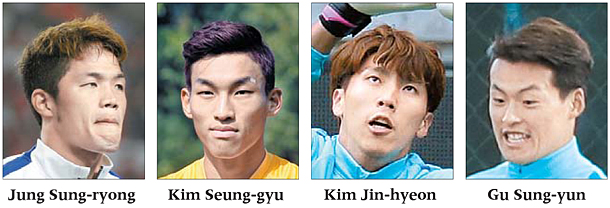Homegrown goalkeepers make mark in Japanese football

Three players currently competing for the starting goalie position in Korea’s national football team have met on the Japanese pitch: Jung Sung-ryong, Kim Seung-gyu and Kim Jin-hyeon.
Jung, a veteran goalkeeper who once played for the Suwon Samsung Bluewings, is defending the goalpost for the J1 League’s Kawasaki Frontale. Kim Seung-gyu, who came from Ulsan Hyundai FC plays, for Vissel Kobe, and Kim Jin-hyeon is in Cerezo Osaka, currently part of Japanese football’s second-tier J2 League.
Another rising star, Gu Sung-yun, who led Korea’s national football team to the quarterfinals of the AFC U-23 Championship in January 2016, is playing in the J2 League, guarding the net for Consadole Sapporo.
All four players are performing well. Jung, the most senior among them, has been holding down the defense line for Kawasaki, which used to let in a few goals because of their full-on aggressive tactics. Although Jung couldn’t participate in the latter half of the season due to a knee injury, he managed an impenetrable defense, allowing only 1.07 goals per game on average. While Kawasaki had only six games in which the team lost no points last year, the team managed 12 clean sheets this year.
Having overcome their chronic shakiness in defense with a reliable goalkeeper, Kawasaki finished this year’s league in second place based on total goals scored. The team ended up in sixth for least amount of points lost, letting in 39 goals in a total of 34 games.
Jung’s counterpart in Vissel Kobe, Kim Seung-gyu, has been well known for his dramatic saves whenever the team is in a pinch. Despite the fact that Kim let in the most goals among the four Korean goalies, allowing 1.26 on average, he left an impression on the audience with his showmanship during games. After the season was over, Kim was named an outstanding player by coaches and team members in the Japanese league.
Further south, Kim Jin-hyeon, dubbed the “Patron Saint of Osaka,” helped elevated his team to the first-tier J1 League during the second half of the season by losing only 40 goals in 39 games.
Meanwhile in Sapporo, Gu Sung-yun, the youngest of the four Korean goalies in Japan, lost just an average of 0.67 goals per game. Gu finished 33 games in the league with just 22 goals lost and led Sapporo to victory in the J2 League, helping it move up to the first-tier J1 League for the first time in five years. In the last game of the season held on Nov. 20, the 34,000 fans in the Sapporo Dome cheered Gu Sung-yun’s name after the game was over.
Football watchers believe there are two reasons why the Japanese football league is eyeing Korean goalkeepers. For one thing, Korean goalies are taller than their Japanese counterparts. While the average Japanese goalkeeper is 1.85 meters tall (6-foot-1), Jung is 1.90 meters, Kim Seung-gyu 1.87 meters, Kim Jin-hyeon 1.92 meters and Gu 1.95 meters.
“Tall goalkeepers over 1.90 meters are rare in Japan,” said sports columnist Shin Mu-gwang. “Korean goalies not only have good physique, but they’re also agile and have a high level of judgment [for games] and so they’re very popular in Japan.”
Another explanation for their high demand in the Japanese league is their active participation in games. “Japanese goalies tend to focus mostly on their goalkeeping role,” Jung said. “But Korean players actively lead the defense line in games and build up the game [by passing from the defense zone toward the opposition]. I think these reasons are getting us positive reactions.”
Football teams in the Japanese league are now paying more for Korean goalkeepers. Top-ranked teams are already contacting Kim Seung-gyu and Kim Jin-hyeon to play for them. Young footballers who played at the Olympic Games have also piqued the interest of Japanese clubs, including Lee Chang-keun from Suwon and Kim Dong-jun of Seongnam FC.
“We have excellent goalkeepers in Japan like Eiji Kawashima and Shusaku Nishikawa, but in the J-League overall, we lack goalkeepers with stability,” Shin said. “The reality is that senior players who are in their late 30s like Seigo Narazaki and Hitoshi Sogahata are considered class-A players. Korean goalkeepers show high-quality performance and competitiveness, so their popularity will keep increasing in the J-League.”
BY SONG JI-HOON [yoon.soyeon@joongang.co.kr]










with the Korea JoongAng Daily
To write comments, please log in to one of the accounts.
Standards Board Policy (0/250자)